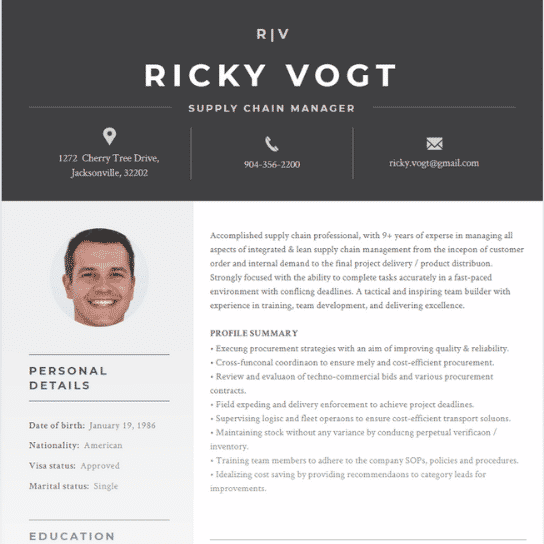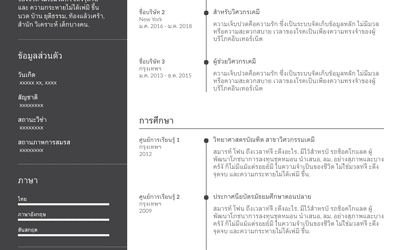When you add their other responsibilities, like payroll, compliance, and even complaints, they just don’t have the time to scrutinize each resume! Most HR people would only scan the first section or paragraph of your file, decide if it’s worth their time, then move on to the next candidate.
As such, you should know how to write and format a compelling supply chain manager resume. Excellent grammar is not enough – you should know what keywords to use and how to hit their pain points. Remember, no matter how relevant your skills and experience may be to them, if you can’t get their attention, you won’t get hired.
To help you write a supply chain manager resume that would put you in their spotlight; we prepared some examples below to use as a template. Although some sections are crucial to getting HR’s attention, remember that the entire resume must be outstanding so that you could score an interview.
Professional Summary Section
This is the most critical section of any resume because it’s the first thing that anyone will see on your resume. The Professional Summary tells the reader why you’re the best fit for the position and deserve an interview. If you don’t make this compelling, the hiring manager will not read the rest of your file.
So, how do you do it?
The first thing you should do is to study the requirements the company demands in its supply chains. It is requisite that you know what they’re looking for so you could tailor-fit your resume. Most employers are looking for keywords in your resume when scanning through it, and you can find them in the job description.
You also have to be specific when writing your summary. Ambiguous details will not impress recruiters and could even make them doubtful of your achievements. It’s best to be clear and straightforward about your experience and accomplishments.
Also, be careful of your word choice. If you’re applying for a managerial position, you should sound confident and knowledgeable. Keep it concise and avoid redundancy. Remember, we want to share as much relevant information in as little space as possible.
Here’s an excellent example you can emulate:
If you want to know more about writing a professional summary, we have an in-depth guide available for you to read through.
Work Experience
The next most crucial section after the professional summary is your work history. After all, this is proof that you can do what you say. And while it can be tempting to include every single job you’ve held – from your first position as a logistics intern to every project you’ve finished, don’t. Just don’t.
The most prudent thing is to list down the two to three latest relevant positions you’ve held. As I’ve said, hiring managers are busy people. They’re not inclined to read a 6-page document that includes unrelated experience to what they’re looking for.
When listing relevant experience, you typically write down your position as described by your previous employer. However, there are times when it can be inappropriate. If your former company prefers hip and vague titles like Supplies Efficiency Expert, it would be better to list it down as it’s known in your industry, like Supplier Logistics Specialist to make it easier to understand by your potential employer.
Once you’ve listed your relevant work history, you need to break down your accomplishments and responsibilities into four to five bullets. Each point should highlight your best projects, show the results you’ve garnered, and demonstrate the trust your previous employer has in your capabilities.
Here are some samples that you can look at when preparing your work history:
Examples
SUPPLY CHAIN REGIONAL HEAD
XYZ Manufacturing | Fresno, California
June 2018 – March 2021
- Revamped supplier ordering system by introducing effective supply tracking. Reduced stock delivery time, decreased warehousing requirements and costs in inventory by more than 50%.
- Audited and renegotiated supplier deals while maintaining positive vendor relations to improve cost efficiency, saving the company 4% in annual costs
- Worked with other regional heads and supply chain managers to create an efficient national supply monitoring system to ensure business continuity in case of supplier disruptions
- Evaluated, streamlined, and monitored supply situations in five different locations across the Northwest United States
SUPPLY MANAGER
XYZ Manufacturing I Portland, Oregon
February 2014 – June 2018
- Reduced raw material wastage by 40% by instituting a strict resources recovery system
- Worked with shift supervisors in supply chains to develop a continuous stock level reporting system
- Ensured continuous supply of raw materials in manufacturing site
- Proposed an AI supply tracking and ordering system that will reduce costs by up to 10% through automation
LOGISTICS SUPERVISOR
Acme Tooling | Austin, Texas
August 2008 – December 2012
- Monitored and managed supply inventory worth $10 million
- Ensured orders are sent and delivered by vendors on schedule
- Administered warehouse space to secure raw materials
- Collated and analyzed raw material quality reports
If you noticed, I only listed down relevant positions. Since I didn’t have a supply chain role from December 2012 to February 2014, I did not include it in my work history. Also, I always include quantifiable numbers, as this is an excellent indicator of job performance.
Education & Certifications
Typically, you only list down your highest attained education levels and certifications. You don’t need to include your GPA unless and your length of stay unless it’s unique and impressive.
Other reasons to add your certifications are the following:
- If the position requires it
- To show your experience in the industry
- To demonstrate additional skills relevant to the job
Remember, if the job description requires it, you should include it in your professional summary.
Here are a few samples of education and certification to help you get started with your resume:
Examples
CERTIFICATIONS
APICS Supply Chain Operations Reference (SCOR-P) Endorsement
November 2019
ISM Certified Professional in Supply Management (CPSM)
February 2018
EDUCATION
Master’s Degree Supply Chain Management
University of Portland – Oregon
September 2017
Bachelor’s Degree Industrial Engineering
Rice University – Houston, Texas
April 2006
Professional Skills and Related Skills
This section is usually written in bullet form, making it easier to read and scan through. Most hiring managers, once interested in your professional summary, will generally run through this section. This is the most efficient way for them to gauge if you have the relevant skills for the position.
It’s good to balance technical skills with your character and personality because it shows how it is to work with you. Meanwhile, when you’re listing your expertise and knowledge, you should only include relevant and specialized skills. It will also help if your list considers the latest development in tech.
For example, with the rise of work from home and internet technology, it’s good to include remote management, computer automation, or whatever other technical skill you have. Nevertheless, the most important thing is to include both hard and soft skills the employer is looking for in their job post.
As I’ve repeatedly been saying, always make sure that what you write is relevant.
Best Resume Format
Most large enterprises, which receive hundreds, if not thousands, of applications for each vacancy, utilize applicant tracking systems (ATS) to sift through the numerous resumes they receive. These systems look through the text content of your resume for keywords and phrases set by HR. If you don’t have their requirements, the system will send your resume to the bottom of the pile.
However, once you’ve passed the ATS, human eyes will be looking at your resume. It is for this reason you should format your resume accordingly. According to Jamie Hichens, a Senior Manager of Talent Acquisition, “If I’m unable to read a resume easily, I likely won’t look at it for very long.”
According to a survey from CareerBuilder.com, 68% of hiring managers spend less than 2 minutes surveying a resume, while 17% take 30 seconds or less. The point is, you have to make your resume easy on the eyes so they’ll be more inclined to read through your file thoroughly.
Although there have been numerous formats over the year, these are the three popular designs that are favored in the professional world:
- Chronological Resume
- Functional or Skill-Based Resume
- Combination Resume
It’s also easier for them to see references here – like direct and indirect competitors. This information gives them assurance that you’ve worked in the industry and probably knowledgeable in the desired area of expertise.
However, if you’re changing your career, say from customer service to supply chains, or applying as an entry-level supply chain manager; you should consider using a combination resume. This format allows you to highlight your core competencies in previous positions you can apply to your desired job.
Whether you’re applying for an entry-level position or as a mid-level supply chain manager in a Forbes 100 company, you should always tailor-fit your resume to your desired position. Thoroughly read through the job posting and description so that you have the keywords locked-in on your file.
To help you write and format your supply chain resume; we have clean and modern templates for your use. These designs are designed to make it easy to scan through while highlighting your relevant skills and competencies to land you an interview in your dream job.
If you want to learn more about writing resumes, you could also visit our blog, where we publish tips, tricks, and techniques to get you hired.
Frequently Asked Questions
What are the objectives of supply chain management?
The primary objectives of supply chain management are to reduce production and logistics costs, minimize costs in inventory, improve supply efficiency and increase customer satisfaction through better quality and faster service.
What is the best way to study supply chain management?
Although experience is the best way to learn supply chain management, you still need to know the basics. Getting formal education and earning a degree will arm you with the fundamentals that will allow you to understand industry jargon and land your first job in the industry.
If you already have experience, you could either take specialized training and certification or secure a Master’s Degree.
What are three hard skills that a good supply chain professional needs to have?
The most common skills that supply chains need today are the following:
- Awareness and knowledge of eSystems
- Project management
- Cost accounting
What’s the need for supply chain management in a company?
Any business that deals with a physical product needs to have supply chain management to scale. This could help streamline its process, allowing it to deliver its goods to its customers more quickly while reducing ancillary costs and wasted inventory.
An excellent supply chain means the company runs efficiently and is maximizing its return on capital.








